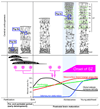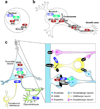Neurodevelopmental mechanisms of schizophrenia: understanding disturbed postnatal brain maturation through neuregulin-1-ErbB4 and DISC1
- PMID: 19712980
- PMCID: PMC2755075
- DOI: 10.1016/j.tins.2009.05.007
Neurodevelopmental mechanisms of schizophrenia: understanding disturbed postnatal brain maturation through neuregulin-1-ErbB4 and DISC1
Abstract
Schizophrenia (SZ) is primarily an adult psychiatric disorder in which disturbances caused by susceptibility genes and environmental insults during early neurodevelopment initiate neurophysiological changes over a long time course, culminating in the onset of full-blown disease nearly two decades later. Aberrant postnatal brain maturation is an essential mechanism underlying the disease. Currently, symptoms of SZ are treated with anti-psychotic medications that have variable efficacy and severe side effects. There has been much interest in the prodromal phase and the possibility of preventing SZ by interfering with the aberrant postnatal brain maturation associated with this disorder. Thus, it is crucial to understand the mechanisms that underlie the long-term progression to full disease manifestation to identify the best targets and approaches towards this goal. We believe that studies of certain SZ genetic susceptibility factors with neurodevelopmental implications will be key tools in this task. Accumulating evidence suggests that neuregulin-1 (NRG1) and disrupted-in-schizophrenia-1 (DISC1) are probably functionally convergent and play key roles in brain development. We provide an update on the role of these emerging concepts in understanding the complex time course of SZ from early neurodevelopmental disturbances to later onset and suggest ways of testing these in the future.
Figures


References
-
- Lewis DA, Levitt P. Schizophrenia as a disorder of neurodevelopment. Annu Rev Neurosci. 2002;25:409–432. - PubMed
-
- Rapoport JL, et al. The neurodevelopmental model of schizophrenia: update 2005. Mol Psychiatry. 2005;10:434–449. - PubMed
-
- Buka SL, Fan AP. Association of prenatal and perinatal complications with subsequent bipolar disorder and schizophrenia. Schizophr Res. 1999;39:113–119. discussion 160-111. - PubMed
-
- Pantelis C, et al. Neuroanatomical abnormalities before and after onset of psychosis: a cross-sectional and longitudinal MRI comparison. Lancet. 2003;361:281–288. - PubMed
Publication types
MeSH terms
Substances
Grants and funding
LinkOut - more resources
Full Text Sources
Other Literature Sources
Medical

